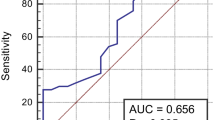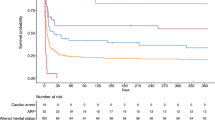Abstract
To determine the effects of different prognostic factors, including previous antiplatelet therapy, admission data, and radiographic findings on discharge and 3-month neurological condition using modified Rankin scale (mRS) and mortality at 30 days and 3-month follow-up in patients presenting to the emergency department with spontaneous intracranial hemorrhage (sICH). Between January and July 2012, 120 consecutive patients (males 62 %, females 38 %), who were admitted within 48 h of symptoms onset, were included. We recorded the following data on admission: demographics; functional scores of ICH, Glasgow Coma Scale, and National Institutes of Health Stroke Scale; vital signs; smoking status; use of illicit drug; preadmission antiplatelet treatment; results of laboratory tests (platelet count, serum glucose, sodium and creatinine levels, and prothrombin time); and primary neuroimaging findings [intraventricular hemorrhage (IVH), midline shift, and hydrocephalus]. In multivariate analysis using adjusted model for demographics and prior antiplatelet therapy; functional scores, laboratory results, and diabetes history correlated with mortality during 30 days after the event. Moreover, the parameters on the initial computed tomography scan significantly increased 30-day fatality rate and was correlated with increase in the discharge mRS score of survivors. The odds ratio (OR) and 95 % confidence interval (CI) of early mortality associated with IVH presentation was 2.34 (CI 1.76–3.02, p = 0.003). The corresponding ORs in those with midline shift displacement and hydrocephalus were 2.18 (95 % CI 2.08–3.80, p = 0.01) and 1.62 (95 % CI 1.01–2.63, p = 0.02), respectively. In patients with ICH, prognostic factors, include various clinical parameters and paraclinical findings of admission time.


Similar content being viewed by others
References
Balami JS, Buchan AM (2012) Complications of intracerebral haemorrhage. Lancet Neurol 11:101–118
Wasay M, Khatri IA, Khealani B, Afaq M (2012) Temporal trends in risk factors and outcome of intracerebral hemorrhage over 18 years at a tertiary care hospital in Karachi, Pakistan. J Stroke Cerebrovasc Dis 21:289–292
Broderick JP, Brott T, Tomsick T, Miller R, Huster G (1993) Intracerebral hemorrhage more than twice as common as subarachnoid hemorrhage. J Neurosurg 78:188–191
Sacco S, Marini C, Toni D, Olivieri L, Carolei A (2009) Incidence and 10-year survival of intracerebral hemorrhage in a population-based registry. Stroke 40:394–399
Broderick J, Connolly S, Feldmann E et al, and the American Heart Association, and the American Stroke Association Stroke Council, and the High Blood Pressure Research Council, and the Quality of Care and Outcomes in Research Interdisciplinary Working Group (2007) Guidelines for the management of spontaneous intracerebral hemorrhage in adults: 2007 update: a guideline from the American Heart Association/American Stroke Association Stroke Council, High Blood Pressure Research Council, and the Quality of Care and Outcomes in Research Interdisciplinary Working Group. Stroke 38:2001–2023
Zia E, Engstrom G, Svensson PJ, Norrving B, Pessah-Rasmussen H (2009) Three-year survival and stroke recurrence rates in patients with primary intracerebral hemorrhage. Stroke 40:3567–3573
Delcourt C, Anderson C. Acute Intracerebral haemorrhage: Grounds for optimism in management. J ClinNeurosci. 2012 Oct 19.pii: S0967-5868(12)00301-3. doi: 10.1016/j.jocn.2012.05.018
Broderick JP, Brott TG, Duldner JE, Tomsick T, Huster G (1993) Volume of intracerebral hemorrhage. A powerful and easy-to-use predictor of 30-day mortality. Stroke 24:987–993
Bilbao G, Garibi J, Pomposo I, Pijoan JI, Carrasco A, Cataln G et al (2005) A prospective study of a series of 356 patients with supratentorial spontaneous intracerebral haematomas treated in a Neurosurgical Department. Acta Neurochir (Wien) 147:823–829
Sampon N, Mendia A, Azkarate B, Alberdi F, Arrazola M, Urculo E (2010) Early mortality in spontaneous supratentorial intracerebral haemorrhage. Neurocirugia(Astur) 21:93–98
Garibi J, Bilbao G, Pomposo I, Hostalot C (2002) Prognostic factors in a series of 185 consecutive spontaneous supratentorial intracerebral haematomas. Br J Neurosurg 16:355–361
Diringer MN, Edwards DF, Zazulia AR (1998) Hydrocephalus: a previously unrecognized predictor of poor outcome from supratentorial intracerebral hemorrhage. Stroke 29:1352–1357
Nilsson OG, Lindgren A, Brandt L, Saveland H (2002) Prediction of death in patients with primary intracerebral hemorrhage: a prospective study of a defined population. J Neurosurg 97:531–536
Wang Y, Lim LL, Levi C, Heller RF, Fisher J (2000) Influence of admission body temperature on stroke mortality. Stroke 31:404–409
Szczudlik A, Turaj W, Slowik A, Strojny J (2002). Hyperthermia is not an independent predictor of greater mortality in patients with primary intracerebral hemorrhage. Med SciMonit 8:CR702–CR707
Stead LG, Jain A, Bellolio MF, Odufuye A, Gilmore RM, Rabinstein A, Chandra R, Manivannan V, Dhillon R, Serrano LA, Yerragondu N, Jain M, Palamari B, Decker WW (2010) Emergency Department hyperglycemia as a predictor of early mortality and worse functional outcome after intracerebral hemorrhage. Neurocrit Care 13(1):67–74
Phan TG, Koh M, Vierkant RA, Wijdicks EF (2000) Hydrocephalus is a determinant of early mortality in putaminal hemorrhage. Stroke 31:2157–2162
Appelboom G, Bruce SS, Han J, Piazza M, Hwang B, Hickman ZL, Zacharia BE, Carpenter A, Monahan AS, Vaughan K, Badjatia N, Connolly ES (2012) Functional outcome prediction following intracerebral hemorrhage. J Clin Neurosci 19:795–798
Teasdale G, Murray G, Parker L, Jennet B (1997) Adding up the Glasgow Coma scale. Acta Neurochir (Wien) 28(suppl):13–16
American Diabetes Association (2012) Diagnosis and classification of diabetes mellitus. Diabetes Care 35(Suppl 1):S64–S71
Rankin L (1957) Cerebral vascular accidents in patients over the age of 60 II. Prognosis. Scott Med J 2:200–215
Franke CL, van Swieten JC, Algra A, van Gijn J (1992) Prognostic factors in patients with intracerebral haematoma. J Neurol Neurosurg Psychiatry 55(8):653–657
Bamford J, Sandercock P, Dennis M, Burn J, Warlow C (1997) A prospective study of acute cerebrovascular disease in the community: the Oxfordshire community stroke project 1981–86, 2. Incidence, case fatality rates and overall outcome at 1 year of cerebral infarction, primary intracerebral and subarachnoid haemorrhage. J Neurol Neurosurg Psychiatry 53:16–22
Weimar C, Weber C, Wagner M et al (2003) Management patterns and health care use after intracerebral hemorrhage. a cost-of-illness study from a societal perspective in Germany. Cerebrovasc Dis 15:29–36
Flaherty ML, Haverbusch M, Sekar P et al (2006) Long-term mortality after intracerebral hemorrhage. Neurology 66:1182–1186
Fogelholm R, Murros K, Rissanen A, Avikainen S (2005) Long term survival after primary intracerebral haemorrhage: a retrospective population based study. J Neurol Neurosurg Psychiatry 76:1534–1538
Shaya M, Dubey A, Berk C, Gonzalez-Toledo E, Zhang J, Caldito G, Nanda A (2005) Factors influencing outcome in intracerebral hematoma: a simple, reliable, and accurate method to grade intracerebral hemorrhage. Surg Neurol. 2005 Apr;63(4):343-8; discussion 348. Erratum in: Surg Neurol 64:279
Daverat P, Castel JP, Dartigues JF, Orgogozo JM (1991) Death and functional outcome after spontaneous intracerebral hemorrhage. A prospective study of 166 cases using multivariate analysis. Stroke 22:1–6
Fogelholm R, Murros K, Rissanen A, Avikainen S (2005) Admission blood glucose and short term survival in primary intracerebral haemorrhage: a population based study. J Neurol Neurosurg Psychiatry 76:349–353
Passero S, Ciacci G, Ulivelli M (2003) The influence of diabetes and hyperglycemia on clinical course after intracerebral hemorrhage. Neurology 61:1351–1356
Lu A, Tang Y, Ran R, Ardizzone TL, Wagner KR, Sharp FR (2006) Brain genomics of intracerebral hemorrhage. J Cereb Blood Flow Metab 26:230–252
Mechanick JI (2006) Metabolic mechanisms of stress hyperglycemia. JPEN J Parenter Enteral Nutr 30:157–163
Mankovsky BN, Metzger BE, Molitch ME, Biller J (1996) Cerebrovascular disorders in patients with diabetes mellitus. J Diab Comp 10:228–242
Alex M, BaronEK Goldenberg S, Blumenthal HT (1962) An autopsy study of cerebrovascular accident in diabetes mellitus. Circulation 25:663–673
Peterson B, Khanna S, Fisher B, Marshall L (2000) Prolonged hypernatremia controls elevated intracranial pressure in head-injured pediatric patients. Crit Care Med 28:1136–1143
Fang HY, Lin CY, Ko WJ (2005) Hematology and coagulation parameters predict outcome in Taiwanese patients with spontaneous intracerebral hemorrhage. Eur J Neurol 12:226–232
Helweg-Larsen S, Sommer W, Strange P, Lester J, Boysen G (1984) Prognosis for patients treated conservatively for spontaneous intracerebral hematomas. Stroke 15:1045–1048
Tuhrim S, Dambrosia JM, Price TR, Mohr JP, Wolf PA, Heyman A, Kase CS (1988) Prediction of intracerebral hemorrhage survival. Ann Neurol 24:258–263
Steiner I, Gomori JM, Melamed E (1984) The prognostic value of the CT scan in conservatively treated patients with intracerebral hematoma. Stroke 15:279–282
Juvela S (1995) Risk factors for impaired outcome after spontaneous intracerebral hemorrhage. Arch Neurol 52:1193–1200
Toyoda K, Okada Y, Minematsu K, Kamouchi M, Fujimoto S, Ibayashi S (2005) Antiplatelet therapy contributes to acute deterioration of intracerebral hemorrhage. Neurology 65:1000–1004
Saloheimo P, Ahonen M, Juvela S, Pyhtinen J, Savolainen ER, Hillbom M (2006) Regular aspirin use preceding the onset of primary intracerebral hemorrhage is an independent predictor for death. Stroke 37:129–133
Thompson BB, Be′jot Y, Caso V et al (2010) Prior antiplatelet therapy and outcome following intracerebral hemorrhage: a systematic review. Neurology 75:1333–1342
Author information
Authors and Affiliations
Corresponding author
Rights and permissions
About this article
Cite this article
Mansouri, B., Heidari, K., Asadollahi, S. et al. Mortality and functional disability after spontaneous intracranial hemorrhage: the predictive impact of overall admission factors. Neurol Sci 34, 1933–1939 (2013). https://doi.org/10.1007/s10072-013-1410-0
Received:
Accepted:
Published:
Issue Date:
DOI: https://doi.org/10.1007/s10072-013-1410-0




